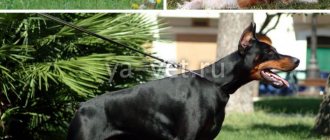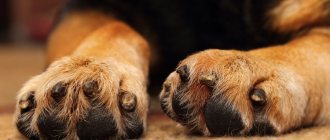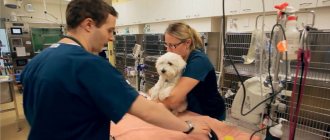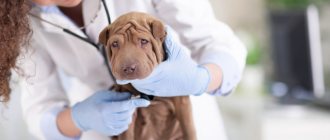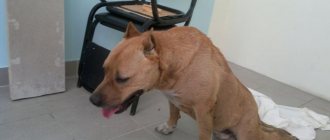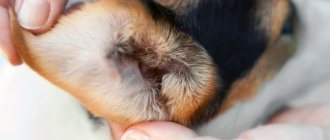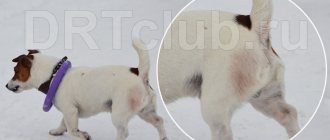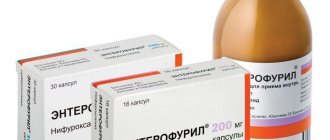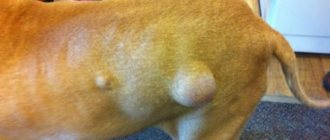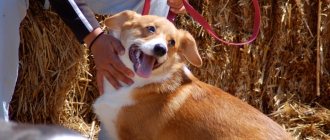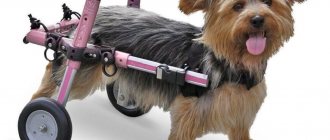A dog is man's best friend. And it is desirable for a person to know how to help a smaller comrade in a dangerous situation.
A dog can get injured while walking, in the yard, during training, fighting with other animals, or worst of all, colliding with a car on the road. The wounds can be minor or serious, and the poor animal is unable to help itself. Only people will be able to ease the torment and help him out. Therefore, even if a person does not have his own dog, he should understand how to provide medical support to a furry friend and how to treat a dog’s wound.
First aid for a cut on a dog
Surely, all dog lovers know how their restless pets love to poke around everywhere, and end up getting scratches and cuts. Paws are especially often cut, since the ground, unfortunately, is strewn with various caustic debris - this includes broken glass, and building materials, pieces of iron, and wire. In this case, there is no need to panic. In general, it is necessary to perform the same manipulations that are undertaken in relation to a person.
Treatment
The order of planned actions:
- rinse the cut with purified cool water;
- trim around, or even shave off the fur;
- Treat the area surrounding the cut with hydrogen peroxide - it perfectly disinfects, removes dirt and stops bleeding.
When the blood is stopped with peroxide, you can use furatsilin - it will not cause pain and will wash the cut again. The solution is prepared very simply: 2 tablets, crushed to a powder, pour half a glass of boiling water, after thoroughly mixing with cotton wool, the solution is applied to the damaged surface.
After cleaning the wound, you need to assess its depth and severity. If the cut is not deep and small (no more than 2 cm wide), then it does not need to be stitched. Otherwise, without delay, seek the services of a surgeon.
When it is not possible to do this, you can help the poor pet on your own. The main thing is not to be afraid and act calmly.
How to treat a dog's paw, the most vulnerable affected area, or cuts in other places:
- Pull the edges of the cut and the skin as tightly as possible to each other and apply an adhesive plaster and bandage;
- If there is little bleeding, you can also soak cotton wool in peroxide, wrap it in gauze and press it to the cut, and bandage the top tightly.
If the injury is not serious enough to require professional treatment from a veterinarian, home remedies can help promote rapid healing.
It is useful to rinse minor damage with chlorhexidine 2-3 times a day: draw the solution into a syringe without a needle and pour it as deeply as possible. Carry out such procedures until completely tightened. Don't forget to apply hydrogen peroxide to the edges of the cut.
How to treat injuries in dogs after first aid? It is optimal to treat large cuts with ointments - healing, anti-inflammatory. It is good to put drugs such as iruksol, levomekol, streptomycin deep into the wounds.
If possible, powder the injured area with powder several times a day.
Also change the bandage 2-3 times a day.
You need to make sure that the dog does not touch the cut or lick it, otherwise the regeneration period will be long. A dog's saliva contains a lot of bacteria that can only make things worse. For these purposes, you can use a special surgical collar.
On the street, the pet will have to wear a dog boot or sock made from a plastic bag with foot wraps.
Throughout the healing period, it is necessary to control the dog’s movements, limiting its activity and avoiding putting stress on the sore paw.
On average, the wound will heal in 1-3 weeks.
What should you not do if you are injured?
- Remove large debris from the wound yourself. There is a high risk of bleeding.
- Use hydrogen peroxide, iodine, brilliant green for deep injuries.
- Allow the animal to lick the damaged area. The mouth and saliva itself contain bacteria. They will easily take over the damaged area and begin to multiply. This will lead to suppuration, which will slow down recovery and complicate treatment.
- Use cotton wool. It consists of many thin fibers. They stick to tissues and become another place for pathogenic microflora to reproduce.
- Apply a tourniquet. In our pets, the relative position of the bones and arteries does not make it possible to properly stop the bleeding. Most likely, you will simply clamp not an artery, but a vein, and the bleeding will only intensify.
How to stop bleeding
A dog may come running home bleeding profusely and scare its owners. Sometimes, if the bleeding is not stopped immediately, the animal dies from its loss.
In fact, there is nothing complicated about this technique. In case of a wound on the face or paws, a tight bandage is sufficient, because there are no large vessels in these areas.
But when the wound is dangerous and there is a lot of blood, immediately apply a tourniquet. Remember that in warm weather it is applied for 1-2 hours, in cold weather - 3 hours, no more.
Having stopped the bleeding, emergency care is already provided, starting with washing the injury and ending with a bandage.
In what cases should you contact a veterinarian?
Even if you provided first aid to your dog and properly treated its wound, you should not neglect a visit to a specialist. Only a veterinarian can assess how badly the limb is cut and apply stitches if necessary. He will also tell you how to treat your pet.
It often happens that foreign objects that are not visible to the naked eye get into a narrow deep wound, and surgical intervention will be required to remove them.
It is imperative to take your dog to the veterinarian in the following cases:
- tissue cuts between fingers;
- deformations of tendons, ligaments;
- damage to the nail plate or joint.
Such injuries can lead to interdigital inflammation, skin rejection and, as a result, complete limitation of movement.
Treatment of wounds depending on their complexity
There is a natural and medical gradation of wounds by depth, type, and complexity. In any case, the dog owner should know how to treat the dog’s wound in order to get the pet to the veterinary clinic in time without allowing it to bleed to death.
Small and superficial wound
The algorithm is simple:
- wash the wound with furatsilin, rivanol or hydrogen peroxide;
- treat the edges with brilliant green;
- apply a bandage.
If there are no medications at hand, you can clean the wound with drinking water, cover it with a plantain leaf and also bandage it with improvised means.
Deep and extensive laceration, but uncontaminated
In this case it is necessary:
- It is necessary to remove the hair around the injury. To do this, generously lubricate it with alcohol, iodine, vodka or gasoline, without touching the wound itself, as this will cause severe pain to the dog. Then trim the hairs, avoiding them getting into the wound.
- Now you need to apply a tight bandage and take your pet to a veterinary surgeon, since you will not be able to eliminate all the consequences on your own.
Deep and extensive laceration, heavily contaminated
You should:
- Clean the wound by rinsing with hydrogen peroxide, a solution of furatsilin, rivanol or a weak concentration of potassium permanganate. You can use cold boiled water.
- Then treat the edges of the wound with iodine, brilliant green or peroxide. Make a bandage
- You can put a cotton swab soaked in peroxide and wrapped in a bandage under it.
- Take your dog to the vet immediately.
Paw cut
Most often a wound appears on a dog's paw. Fortunately, the list of necessary measures is quite simple.
- wash the wound with a disinfectant solution;
- treat the edges with iodine, peroxide, brilliant green, creolin;
- apply a tight bandage with a cotton swab and bandage tightly again;
- When going for a walk, wear a special shoe or sock.
Penetrating chest injury
This is a very serious injury to your pet. Symptoms include wheezing exhalations and bloody foam protruding from the wound and being sucked back in when inhaling.
You need to react quickly and soberly to prevent the dog from dying from suffocation.
Algorithm:
- quickly treat the edges of the wound with iodine or brilliant green;
- Lubricate the fur around a radius of 5 cm with Vaseline;
- apply a sealed material to the wound - a plastic bag, film, paper, apply cotton wool on top and bandage it;
- as an alternative, you can make a tampon from gauze, cotton wool and bandages, moisten it generously in a disinfectant solution and cover the wound with it, bandage the top with several layers of bandages;
- Deliver your pet to a veterinary hospital within 6-8 hours.
Abdominal injury
Such damage can lead to intestinal prolapse and death. If the intestines do not fall out, proper medical care increases the animal's chances of survival. Find a piece of dense fabric and use it to disinfect the wound - the usual furatsilin is best.
What to do:
- moisten a clean cloth in a solution of furatsilin, rivanol, baking soda and cover the wound with it to prevent the intestines from drying out;
- secure with adhesive tape or medical glue;
- Do not water or feed your pet! Since the organs of the gastrointestinal tract may be damaged or perforated;
- immediately, no later than 4-6 hours, take to the clinic.
It is impossible to control the movements of our four-legged friends, because they are very playful, inquisitive and active. No matter what happens, you must remain sane and calm, act quickly and carefully. You need to remember that time is precious and, after providing first aid, show your furry pet to a specialist. Do not skimp on affection and care, thus contributing to an even faster recovery of the dog.
How to walk with an animal
Even if a dog hurts its paw pad, this is not a reason to completely give up walking with it. For the first two days, it will be difficult for your four-legged pet to move, but then walking with him is not only possible, but also necessary. To prevent the wound from worsening and the inflammatory process from developing, a sock should be put on the foot and a bag secured with adhesive tape or tape on top of it.
When walking with your dog, you need to make sure that it does not step on sharp stones and glass; at home, you need to make sure that it does not play with sharp, piercing or cutting objects.
How to prevent paw cuts
To avoid injuring your pet's paws, try not to walk in areas where broken glass or other sharp objects may be scattered. Pay close attention to where your dog is running.
Of course, it is impossible to predict and prevent everything, as happened in our case. Therefore, try to be more clean yourself and do not leave broken glass, sharp skewers, barbecues after frying kebabs and other garbage in nature, because this can lead not only to cuts on the paws of our four-legged animals, but also to other consequences.
Purulent wounds
If the wound occurred after surgery and after primary surgical treatment, it is considered clean.
But after injury with sharp, relatively clean objects over a short period of time, the wounds are usually considered infected. When the degree of bacterial contamination is high and a pronounced inflammatory process is observed, the wound begins to fester. Causes of purulent wounds:
- insufficient hygiene when dressing,
- lack of seam care,
- low dog immunity,
- unhealthy diet
- vitamin deficiency.
Symptoms and signs that indicate a purulent process:
- there is swelling around the wound,
- tissues near the wound become hot,
- the dog whines in pain when touched,
- the temperature rises,
- appetite decreases,
- general condition is depressed.
Closed wounds with deep damage and a narrow entrance hole are especially susceptible to suppuration. Because of this, air does not enter the wound, and suitable conditions are created for the proliferation of pathogens.
Lacerations
A laceration occurs when the integrity of tissue is damaged by sharp objects. These could be: fangs and claws of other animals, a piece of iron or iron wire, a stone. In this case, sharp objects inflict a wound in an oblique direction, in contrast to a cut wound with smooth edges. The skin with such a wound is torn unevenly and diverges into flaps at the edges.
During the examination, the veterinarian can observe torn ligaments, tendons, muscles, blood vessels, fascia (the connective tissue membrane of muscles, organs, vessels, nerves).
What is the danger?
Such a wound becomes a favorable environment for the development of infections, because dirt accumulates on its edges, and torn edges take a long time to heal. There is a high risk of an inflammatory process.
Lacerated wounds are stitched up in a veterinary clinic, where you should go as quickly as possible - before inflammation begins.
How to apply a bandage so your dog can't remove it
- To prevent the four-legged animal from tearing off the bandage, put a sock on it, and secure it with a plaster or tape over the sock. If you need to change the compress, you can simply cut the tape.
- If your dog rips off a bandage or licks a wound, place a surgical collar on the animal to prevent it from reaching the injured limb.
Preventing cuts
The following measures will help prevent paw injuries:
- walking on a leash: the vigilant owner will remove fragments of bottles, wood chips and other sharp objects from the path of the four-legged companion;
- making promenades in specially designated areas that are regularly cleaned by utility workers;
- wearing shoes for dogs with thick soles, which will protect not only from cold and rain, but also from sharp stones, bugs scattered on winter roads, shards of ice or glass;
- preventing the dog from coming into contact with dangerous household “toys”: needles, scissors, screws, tin cans.
Take care of your restless pet. May his omnipresent paws always remain safe and sound. If trouble happens, limit yourself to first aid, and entrust the treatment to a doctor.
What to do if the wound does not heal
If the wound does not heal for a long time, you should understand the reasons for this process. A similar feature occurs in older animals and bitches after childbirth, since their immunity is weakened. To speed up regeneration, it is necessary to increase the number of treatments, as well as include wound-healing drugs in the form of ointments, for example, Panthenol or Levosin, in the treatment.
Often, tissue damage does not heal if the dog constantly licks or scratches it. To avoid this, be sure to wear a collar and cover it with a bandage. Limit active games and walks outside as much as possible. If there are no results for more than a month, suppuration appears, contact a veterinarian.
Briefly about the main thing
- Dogs are susceptible to various injuries due to their activity. Wounds can be punctures, cuts, lacerations. Common abrasions and scratches are more common.
- Minor damage is enough to rinse and treat with an antiseptic. For deep wounds, you must first stop the bleeding, then disinfect the surface and consult a doctor.
- To treat weeping and lacerated wounds, antibiotics are prescribed for up to 14 days. This avoids suppuration and necrosis.
- If the damage does not heal, it is necessary to use wound healing drugs.
Have you ever experienced wounds on your dog? Share in the comments how to provide first aid to your pet.
Did you like the article? Share it with your friends on social media. networks. This will help them get useful information and support our project.
